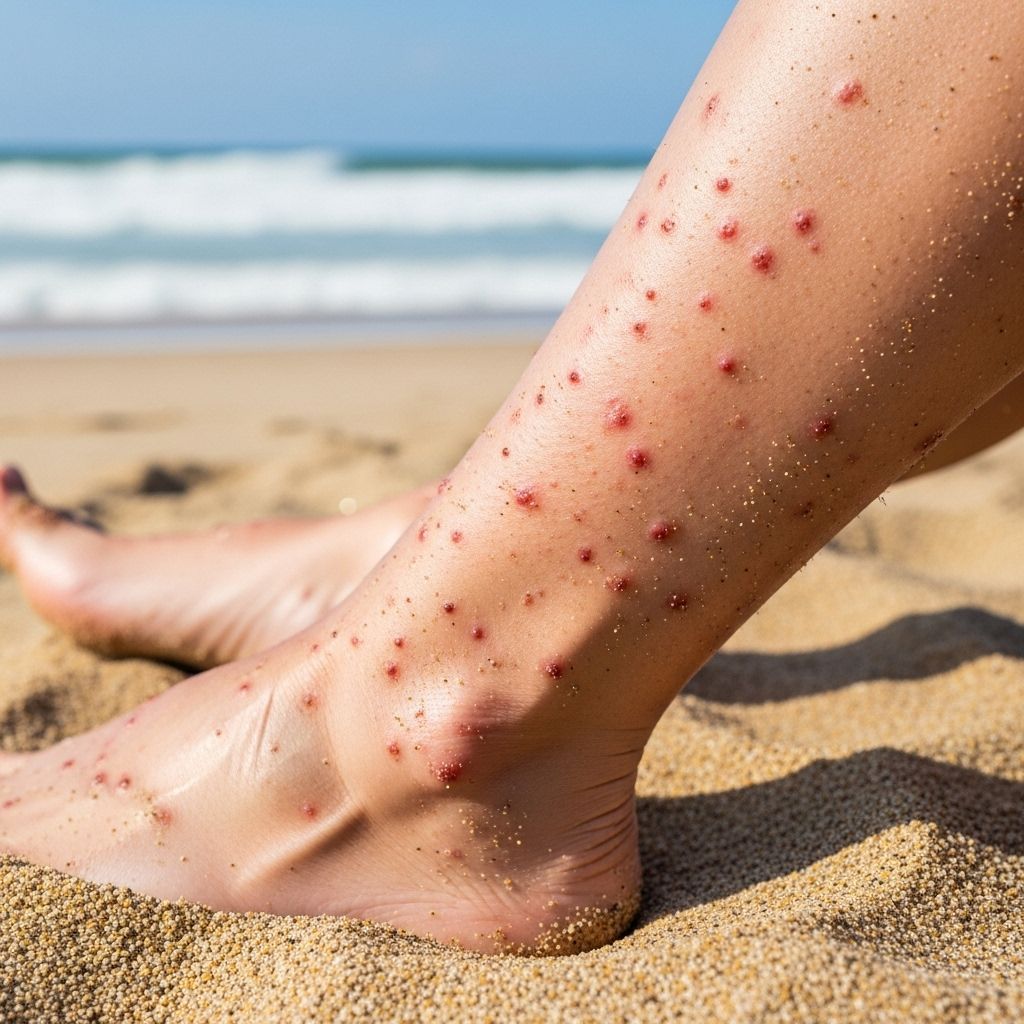Sand Flea Bites: Prevention, Treatment, and Care
Keep irritating red marks at bay when enjoying the coast with easy protective measures.

Sand Flea Bites: Everything You Need to Know
Enjoying a day at the beach or spending time outdoors should be relaxing, but pesky sand fleas can quickly turn an outing into an uncomfortable experience. These tiny insects can leave behind itchy, red marks, and if not managed properly, may lead to further skin complications. This guide provides a comprehensive overview on how to prevent, identify, and treat sand flea bites, ensuring you can enjoy the coastline safely.
What Are Sand Fleas?
Sand fleas, sometimes called beach fleas or sand flies, are tiny crustaceans that live in sandy areas near water, most notably on beaches. While they are not technically fleas—many are small amphipods or the Tunga penetrans species—they can bite humans and animals, causing irritation and discomfort. Some sand fleas can even burrow into the skin and feed on blood, a condition known as tungiasis.
Symptoms of Sand Flea Bites
- Red, itchy bumps on the skin that resemble mosquito bites.
- Clusters of bites, often on exposed areas such as ankles, calves, or the backs of thighs.
- Intense itching or a burning sensation, especially after scratching.
- Swelling, and in rare cases, signs of infection such as pus or increased pain.
- Sometimes, sand fleas may burrow into the skin, causing a small sore or lesion (tungiasis).
How Do Sand Flea Bites Happen?
Sand fleas are most active during cooler and moist conditions, especially right after rain or in the early morning and late afternoon. Sitting or lying directly on sand or near the water’s edge exposes your skin to these pests. The backs of thighs, ankles, and feet are frequent targets because they often come into contact with sand.
Prevention: How to Avoid Sand Flea Bites
- Avoid visiting beaches during damp, cool conditions—after rain or in the early morning hours.
- Visit beaches between mid-morning and early afternoon, when sand fleas are less active.
- Wear protective clothing: closed-toe shoes, long pants, socks that cover your ankles, and longer shorts for sitting.
- Use insect repellents containing DEET or permethrin on exposed skin and clothing.
- Put a barrier between yourself and the sand, such as a towel, beach blanket, or a lawn chair.
- Shake towels, blankets, and beach gear before use to remove insects.
- Choose light-colored clothing to spot any pests more easily.
- Keep skin clean and dry while outdoors to reduce attraction and irritation.
- For extra caution, use specialized repellents such as plant-based Zanzarin® or insecticides where available.
Treating Sand Flea Bites: Home Remedies & Medical Strategies
If you suspect you’ve been bitten by sand fleas, rapid action can minimize discomfort and speed healing. Treatment combines home remedies and over-the-counter products to soothe symptoms.
Home Remedies
- Baking Soda Paste: Mix baking soda with water and apply to the bite to reduce itch and irritation.
- Oatmeal Baths: Add colloidal oatmeal to a lukewarm bath to soothe inflamed skin and relieve itchiness.
- Essential Oils: Dab diluted tea tree, lavender, cedar, or eucalyptus oil to the affected area to reduce swelling and provide natural relief.
- Aloe Vera: Apply fresh aloe vera gel to soothe skin and help with healing.
- Vinegar: A small amount of vinegar (apple cider or white) can help relieve itching due to its acidity.
Over-the-Counter Treatments
- Antihistamines: Oral tablets or topical creams to relieve itching and allergic reactions.
- Hydrocortisone Cream: Reduce inflammation and soothe itching by applying hydrocortisone to the bite.
- Calamine Lotion: Helps dry out blisters and relieve itchiness.
- Corticosteroid Creams: Stronger anti-inflammatory effect, suitable for more severe reactions.
Note: Avoid scratching the bites, as this can lead to secondary infections. Use cool, damp compresses for immediate relief. If itch or discomfort persists, consult a dermatologist for advanced care.
When to Seek Medical Attention
- Signs of infection (pus, increased redness, heat, swelling).
- Development of blisters, ulcers, or if a sand flea has burrowed into the skin (tungiasis).
- Severe allergic reactions, difficulty breathing, or facial swelling.
- Bites that last longer than one week or worsen.
In cases of tungiasis, a healthcare provider must remove the flea to prevent complications such as infection, ulceration, or other more serious conditions associated with the burrowing flea.
Sand Flea Bite Myths & Facts
| Myth | Fact |
|---|---|
| Sand fleas are only found at tropical beaches. | They live in sandy areas worldwide, including temperate locations. |
| Sand flea bites always cause serious disease. | Most bites are minor irritations; disease risk is low except with tungiasis. |
| Any insect repellent will protect against sand fleas. | Check repellent label for efficacy against fleas, not just mosquitoes. |
| All sand flea bites require medical attention. | Most bites can be managed at home with simple remedies. |
Dealing with Sand Flea Infestations
If sand fleas are a recurring problem at home or in your yard, prompt action can control their population and prevent further bites.
- Diatomaceous Earth and Boric Acid: Sprinkle on carpets and outdoor areas to kill fleas by dehydration.
- Vacuum Frequently: On carpets, rugs, and furniture to remove adult fleas and their eggs.
- Wash Bedding and Pet Items in Hot Water: Breaks the life cycle of fleas and reduces infestation risk.
- Use Insect Growth Regulators: These chemicals prevent reproduction and halt the flea reinfestation cycle.
- Consider Professional Pest Control for extensive infestations to ensure thorough elimination.
Who Is Most at Risk?
- Beachgoers—especially those seated or lying directly on the sand.
- Children and Pets, given their tendency to play and roll on sandy surfaces.
- Travelers visiting endemic areas, particularly in the Caribbean, sub-Saharan Africa, and Latin America.
- Individuals with open cuts or sensitive skin may experience worse symptoms.
Frequently Asked Questions (FAQs) About Sand Flea Bites
What do sand flea bites look like?
They typically resemble tiny, red, swollen bumps similar to mosquito bites and often cluster in groups, especially around ankles, calves, or the back of thighs. Severe bites may create blisters or small ulcers.
How long do sand flea bites last?
Most bites resolve in 2–7 days with proper care. If signs of infection, persistent swelling, or worsening symptoms occur, see a healthcare provider.
Can sand flea bites spread diseases?
Regular sand flea bites rarely transmit diseases, but burrowing fleas (tungiasis) can cause infection or ulcers if untreated.
Are sand fleas and regular fleas the same?
No; regular fleas are typically found on pets and in homes, while sand fleas inhabit beach sand and can burrow into the skin, especially in some regions.
Will insect repellent stop sand flea bites?
Quality insect repellents containing DEET or permethrin can help, but ensure the product is labeled effective against fleas, not just mosquitoes.
What should I do if a sand flea burrows into my skin?
Seek medical attention for proper removal and to avoid complications such as secondary infection, and do not attempt to remove the flea yourself.
Expert Tips for Safe Beach Visits
- Plan your beach trips during warmer parts of the day.
- Keep a barrier between your skin and the sand—use a towel, blanket, or chair.
- Apply insect repellent before stepping onto the sand.
- Wear long, breathable protective clothing and closed footwear.
- Shake all beach gear before use to dismiss hidden insects.
- Regularly inspect children’s and pets’ skin for signs of bites if they’ve played on sand.
Conclusion
Sand flea bites are more of a nuisance than a threat when managed properly. Prevention is your best defense, but prompt treatment can soothe symptoms and speed recovery. By understanding how sand fleas behave, adopting best protective practices, and knowing when to seek medical care, you can enjoy outdoor activities with peace of mind and minimal discomfort. If you experience severe or persistent symptoms, don’t hesitate to contact a healthcare professional for advice or treatment.
References
- https://www.absolutefootandankleclinic.com/sand-flea-bites-suck/
- https://pestextinct.com/sand-fleas-what-they-look-like-and-how-to-treat-their-bites/
- https://mosquitonix.com/blogs/news/how-to-treat-sand-flea-bites
- https://my.clevelandclinic.org/health/diseases/24162-tungiasis
- https://www.medicinenet.com/flea_bites_in_humans/article.htm
- https://my.clevelandclinic.org/health/diseases/24458-sand-flea-bites
- https://arrowps.com/sand-fleas-in-florida-identification-behavior-and-bite-prevention/
Read full bio of medha deb











